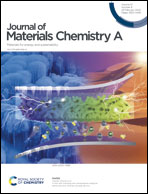Approaching theoretical specific capacity of iron-rich lithium iron silicate using graphene-incorporation and fluorine-doping†
Abstract
Lithium iron silicate, Li2FeSiO4, is a promising cathode material for lithium ion batteries due to its high theoretical specific capacity, earth abundance, low cost, and environmental friendliness. The challenges of Li2FeSiO4 as a practical cathode material are (1) the low electronic and ionic conductivity and (2) the low discharge voltage. The approach of incorporating graphene sheets into the nanostructure of Li2FeSiO4 is used for dealing with the low conductivities while fluorine doping is intended to increase the discharge voltage. The fluorine-doped and graphene-incorporated iron-rich lithium iron silicate F-LFSO/G nanomaterials were successfully synthesized using a facile/efficient hydrothermal method with excellent performance, 328.43 mA h g−1 at 0.1C rate, approaching their theoretical specific capacity, 99% of 331 mA h g−1. This clearly reveals that the reversible (de)lithiation of 2 Li+ ions per F-LFSO has been realized as a result of these approaches. The (de)lithiation process has been studied using in operando high energy synchrotron X-ray absorption near edge spectroscopy and X-ray photoelectron spectroscopy aided by theoretical modeling, which reveals that F doping deeply changes the O electron configuration in F-LFSO, and consequently makes the Li+ ion transfer easier, while the reversible redox of oxygen can be utilized to achieve high specific capacity.



 Please wait while we load your content...
Please wait while we load your content...